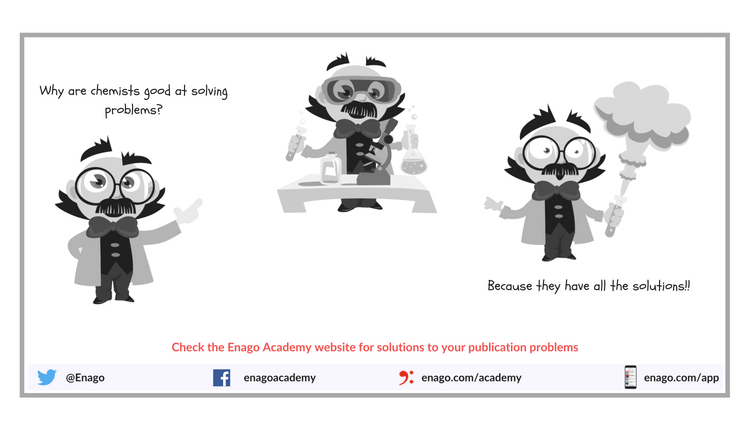Writing in Chemistry (Part 1)

In this article, we state the rules about the format and content of an academic paper in the field of chemistry and describe the scientific conventions used in chemistry papers.
Format and Content of Chemistry Articles
You need to remember that the readers expect two things when reading your paper:
- to understand the information presented
- to know that the findings are legitimate
How Do You Meet These Goals?
- Introduction
- Methods and Materials
- Results
- Discussion
This format may slightly differ depending on the journal, e.g., some ask you to include an abstract or separate section for the hypothesis. Overall, however, this represents a textual version of the scientific method.
Title
Choose terms that are as specific as the text permits
Examples
Avoid: A magnetic alloy
Use: A vanandium–iron alloy
- Refrain from using phrases such as “on the,” “a study of,” “research on,” and “regarding.”
- Refrain from using non-quantitative, meaningless words such as “rapid” and “new.”
Abstract
A good abstract clearly identifies the purpose of the experiment and the important results.
Examples
Avoid pedagogical comments such as,
This experiment helped us learn about the nature of chemical reactions.
or
The goal of this experiment was to learn about dyes.
Avoid starting with “The purpose of this experiment was…” Such background information belongs in the Introduction section.
Avoid referencing. Be specific about what was done.
Examples
Avoid vague statements such as “…a metal complex was prepared and the percent yield was calculated.”
Instead use, “…hexaammine cobalt (III) chloride was prepared from cobalt (II), chloride, and hydrogen peroxide. The yield was 8.45 g.”
Tip 1!
When writing a full report, write the Abstract last.
Introduction
Go step-wise!
- Start by explaining the larger area of the research
- Provide examples of progress in the field
- A clear statement of the research problem
- Approach being addressed in the current report
Examples
Avoid: This experiment intends to investigate upon any measurable amounts of Nickel in the surrounding mud area and within barnacles living on the pilings.
Use: The purpose of this study is to determine the nickel content in the surrounding mud area and in the barnacles living on the pilings.
Methods and Materials
Include a description of your experimental procedure and names of instruments used. Don’t rewrite the lab manual or protocol.
Examples
Avoid: Next, prepare copper solution. Weigh 0.1821 g of copper nitrate and dilute it in 10 mL of tap water.
Use: A solution was prepared by dissolving copper nitrate (0.1821 g) in tap water (10 mL).
Further subdivide into:
- Materials—sources and purity of reagents used
- Preparation of compounds—with procedure and summary of characterization by NMR, IR, etc.
- Instrumentation—manufacturer, description of any adaptation, or sample preparation
Tip 2!
A good materials and methods section should allow the reader to completely reproduce what you did in the lab using what you have written.
Results
Include a summary of your raw data, preferably supported by tables and figures, and important observations.
Tip 3!
Don’t include long tables of raw data, instead simply present the results of your calculations.
Avoid: The following standard concentrations were used to follow X law for the absorbances at the corresponding wavelength (Table).
Use: The standard concentrations were measured at the corresponding wavelengths and the data provided in Table 1.
Figures, Tables, Equations
Explain the purpose of every figure, schemes, equation, and table in the Results section. When referring to a figure, table, or equation, use its number in the text.
Examples
A plateau was observed at reduced pressures >0.1, as indicated in Table 1.
Indicate every figure, table, and equation with a number. Figures and tables require a number and a descriptive title and equations normally have a number placed in parentheses at the right margin.
Examples
Figure 1. Mass Uptake vs. Reduced Pressure for A
Table 1. Powder Diffraction Data Obtained for A
A = B2 (1)
Tip 4!
“Figure” is much preferred presently compared to the labels “chart” and “graph.”
Discussion
- Analyze your results
- Comment on the purpose of the experiment
- Explain what the results indicate
- What are sources of error (experimental uncertainty/precision) and limitations?
- What additional experiments could help address any dangling ends?
- Do the results agree with what others have found?
- Do the results support a model or hypothesis?
Examples
Avoid: If, for example, we could have used a red and green apple to determine the components, we could have averaged the data and obtained more accurate results.
Use: For example, if data were obtained from both a red and a green apple, the averaged results could provide more representative values.
Conclusion
Summarize your results and discussion with a short conclusion, phrasing it in terms of the broader questions addressed in the Introduction.
Tip 5!
When testing a hypothesis, you may want to say that the hypothesis was “proved” or “disproved” or was “correct” or “incorrect.”
Remember, you’re testing a theory with a procedure that lasts only a few hours and relies on only a few trials, which severely compromises your ability to be sure about the “truth” you see.
Therefore, words like “supported,” “indicated,” and “suggested” are more acceptable ways to evaluate your hypothesis.
In the next article, we will discuss the scientific conventions and styles used in Chemistry articles.










Being a chemist and to improve writing skills I want to listen this webinar